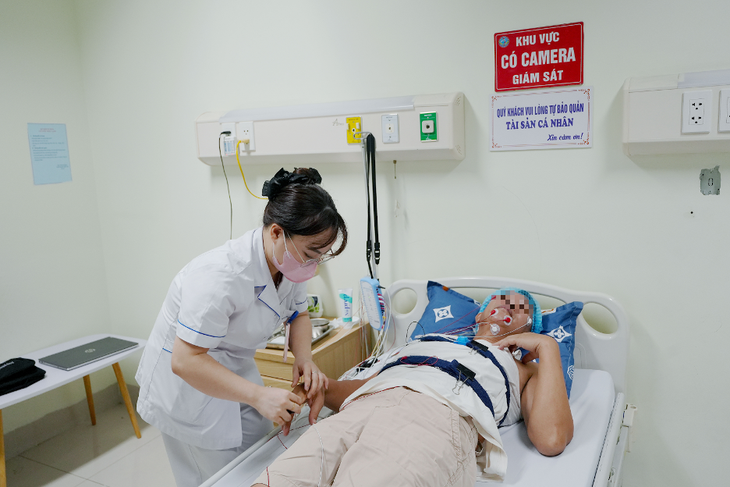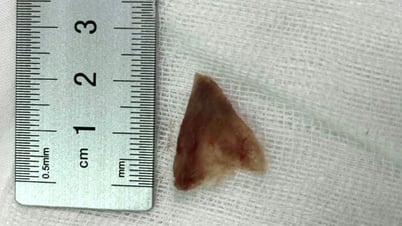
Snoring patients undergo polysomnography at the Central Ear, Nose and Throat Hospital - Photo: BVCC
When snoring needs intervention?
According to doctors at the Central Ear, Nose and Throat Hospital, snoring is a condition in which the flow of air through the airway is narrowed, creating a loud sound while sleeping unconsciously. This is a very common problem in life.
Snoring can be physiological but can also be an early sign of a more serious disorder called obstructive sleep apnea. This is the most common of the sleep-disordered breathing disorders, occurring in both children and adults, more commonly in men than women and increasing with age.
According to Dr. Dao Dinh Thi, head of the endoscopy department at the Central Ear, Nose and Throat Hospital, if the disease is severe, it will cause many health risks. Therefore, treatment is something that needs to be done early.
"Snoring and sleep apnea are two forms of the same disease. Snoring indicates that the airway has narrowed and it signals a larger syndrome, sleep apnea. To accurately determine sleep apnea, it must be based on two aspects: diagnosis and treatment," said Dr. Thi.
Accordingly, the diagnosis is performed through 3 stages of endoscopic examination to determine the stenosis while awake. In addition, to determine the stenosis while sleeping, we perform sleep endoscopy.
The patient is put into physiological sleep with medication. When the patient snores, the doctors will perform an endoscopy to know exactly where the narrowing point is in order to come up with an intervention plan.
In addition, for people with sleep apnea, polysomnography is also performed to determine the severity of sleep apnea.
"Polysomnography is an in-depth sleep test, including channels to measure electroencephalogram, ophthalmogram, electromyogram, electrocardiogram, nasal and oral airflow, chest and abdominal muscle movement, blood oxygen saturation, snoring, body posture, leg movement measurement, and video to monitor events during the night.
Therefore, polysomnography provides complete information about sleep as well as other disorders that occur during sleep such as respiratory disorders, sleep apnea, heart rhythm disorders, movement and behavioral abnormalities...", Dr. Thi explained.
How to treat snoring?
To treat this condition, according to Dr. Thi, the Central ENT Hospital currently has surgeries that respond to most cases of stenosis in the ENT area.
If in the nasal area, the points that cause nasal obstruction such as sinusitis, nasal turbinate reshaping will be treated, then the pharynx, nasopharynx, then techniques such as adenoidectomy. The next level is the palatine layer, which includes techniques such as shrinking the palatine palate, laser burning the palatine palate, or hardening the palatine palate to reduce vibration and noise.
In case of snoring due to tonsils, the tonsils will be removed. If the lingual tonsils are too large, they will be trimmed down. If the larynx and epiglottis are too large, they can also be treated.
According to clinical practice, the treatment success rate is more than 95% in cases of snoring and sleep apnea. In only 5% of cases where the stenosis is too severe and cannot be treated surgically, the patient will have to use a continuous positive airway pressure (CPAP) device while sleeping.
If sleep apnea is not diagnosed and treated promptly, it can lead to serious complications such as myocardial infarction, diabetes, high blood pressure, arrhythmia, stroke...
Therefore, recognizing the disease and treating it properly helps reduce the risk of dangerous complications.
Source: https://tuoitre.vn/ngu-ngay-cung-co-nguy-co-gay-hai-cho-tim-va-nao-20250802071940627.htm



![[Photo] Super harvest moon shines brightly on Mid-Autumn Festival night around the world](https://vphoto.vietnam.vn/thumb/1200x675/vietnam/resource/IMAGE/2025/10/07/1759816565798_1759814567021-jpg.webp)




























































































Comment (0)